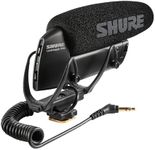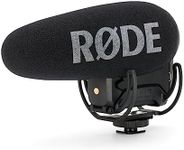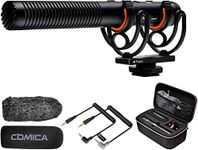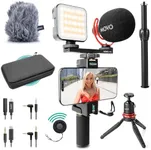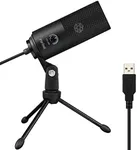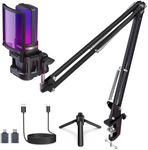Buying Guide for the Best Shotgun Microphone For Dslr Cameras
Choosing the right shotgun microphone for your DSLR camera can significantly enhance the audio quality of your recordings, whether you're shooting videos, interviews, or vlogs. A shotgun microphone is designed to capture sound from a specific direction, reducing background noise and focusing on the subject in front of the camera. To make an informed decision, it's important to understand the key specifications and how they align with your recording needs.Polar PatternThe polar pattern of a microphone describes how it picks up sound from different directions. For shotgun microphones, the most common polar pattern is supercardioid or hypercardioid, which captures sound primarily from the front while rejecting noise from the sides and rear. This is crucial for isolating the subject's voice from ambient noise. If you are recording in a controlled environment with minimal background noise, a supercardioid pattern may suffice. However, for outdoor or noisy environments, a hypercardioid pattern might be more effective in focusing on the subject.
Frequency ResponseFrequency response refers to the range of frequencies a microphone can capture. A wider frequency response means the microphone can pick up a broader range of sounds, from low bass to high treble. This is important for capturing the full richness of the subject's voice or any other sound source. For general use, a frequency response of 20Hz to 20kHz is ideal, as it covers the entire range of human hearing. If you are recording specific types of audio, such as musical instruments, you might need a microphone with a tailored frequency response.
SensitivitySensitivity measures how effectively a microphone converts sound into an electrical signal. Higher sensitivity means the microphone can pick up quieter sounds, which is useful in low-noise environments. However, in noisy settings, a lower sensitivity might be preferable to avoid capturing too much background noise. Consider your typical recording environment: if you often record in quiet settings, a higher sensitivity microphone will capture more detail. Conversely, for louder environments, a lower sensitivity microphone can help reduce unwanted noise.
Signal-to-Noise Ratio (SNR)The signal-to-noise ratio (SNR) indicates the level of the desired signal compared to the level of background noise. A higher SNR means clearer audio with less background noise. This is particularly important for professional-quality recordings where clarity is paramount. Look for a microphone with an SNR of at least 70dB for good quality audio. If you are aiming for the highest quality, especially in professional settings, an SNR of 80dB or higher is recommended.
Power RequirementsShotgun microphones can be powered in different ways, such as through batteries, phantom power from the camera, or both. Battery-powered microphones are convenient for portability and use with cameras that do not provide phantom power. However, microphones that use phantom power can offer more consistent performance and do not require frequent battery changes. Consider your shooting style and equipment: if you need mobility and ease of use, a battery-powered microphone might be best. For studio or stationary setups, a phantom-powered microphone could be more reliable.
Build Quality and DurabilityThe build quality and durability of a microphone are important for ensuring it can withstand the rigors of regular use, especially in outdoor or challenging environments. Look for microphones made from robust materials like metal, and consider features like shock mounts and windshields that can protect the microphone from physical damage and wind noise. If you frequently shoot outdoors or in unpredictable conditions, investing in a durable microphone with protective accessories is essential. For indoor or controlled environments, build quality is still important, but you may not need as many protective features.
